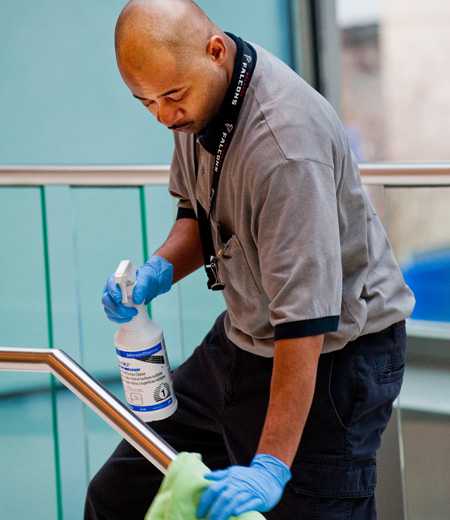Environmental NPIs: Surface Cleaning

What are environmental nonpharmaceutical interventions (NPIs)?
Environmental NPIs include routine surface cleaning that helps to eliminate the flu virus from frequently touched surfaces and objects, such as toys, refrigerator handles, desks, and door knobs in homes, childcare facilities, schools, workplaces, and other settings where people regularly gather.
Public health professionals need the help of administrators of schools, workplaces, and community events to prevent the spread of respiratory illnesses like pandemic flu in their area. Educating and reminding people to clean frequently touched surfaces and objects consistently at home, at school, at work, and at large gatherings are an important part of an organization’s or community’s strategy for minimizing the risks caused by flu and other respiratory illnesses.
Also see how personal NPIs and community NPIs can contribute to an overall strategy for community mitigation of pandemic flu.
The actions you take and plans you make today matter. To ensure the greatest impact, CDC recommends that communities and organizations incorporate a combination of personal, community, and environmental NPIs into their pandemic flu plans.
Why are environmental NPIs important?
The flu virus is thought to spread mainly from person to person through droplets that come from the nose and mouth when a sick person coughs, sneezes, or talks. The flu virus may also spread when people touch contaminated surfaces or objects, and then touch their eyes, nose, or mouth. Many other viruses that cause respiratory illnesses spread this way too.
Flu virus can live and potentially infect other people for up to 48 hours after being left behind on a surface. Although the flu virus can survive on hands for only 3 to 5 minutes, if other people later touch a contaminated surface and then touch their eyes, nose, or mouth, they can be exposed to the flu.
While getting an annual flu vaccination is the best way to prevent seasonal flu, environmental NPIs are simple everyday preventive actions that people take to help lower their risk of coming in contact with flu and other similar viruses on surfaces. Routine surface cleaning acts as an extra layer of protection even after people are vaccinated.
In the event that a new flu virus emerges that can rapidly spread from person to person worldwide, causing a flu pandemic, a vaccine may not be immediately available. During a pandemic, routine surface cleaning becomes an important way that individuals can protect themselves and others from the flu.
Visit other parts of this website to learn about ways that people can protect themselves and others from getting and spreading the flu at home, at school, at work, and at a gathering.
Flu Prevention Tools and Resources for Environmental NPIs
Planning Guidance and Checklists
For more information about Pre-Pandemic Flu Planning visit the Planning Guidance and Checklists page.
Selected Published Research
The following published research includes studies on NPIs conducted by researchers within the past 5 years that are published in peer-reviewed journals. (In alphabetical order by topic.)
Environmental Transmission
Surface Contact Transmission
- Simmerman JM, Suntarattiwong P, Levy J, Gibbons RV, Cruz C, Shaman J, et al. Influenza virus contamination of common household surfaces during the 2009 influenza A (H1N1) pandemic in Bangkok, Thailand: implications for contact transmission. Clin Infect Dis 2010; 51(9):1053-61.
- Thomas Y, Vogel G, Wunderli W, Suter P, Witschi M, Koch D, et al. Survival of influenza virus on banknotes. Appl Environ Microbiol 2008; 74(10):3002-7.
- Page last reviewed: August 2, 2017
- Page last updated: August 2, 2017
- Content source:


 ShareCompartir
ShareCompartir